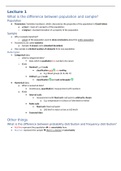Class notes
Biostatics summary and step-by-step plan to solve biostatistical problems
- Course
- Institution
Attention you can buy this document and return in case you did not download it This summary contains not only the summary but also step-by-step plans to help you to solve biostatistical problems. This subject is given to second pharmacy students. So what are you waiting for grap this document an...
[Show more]



